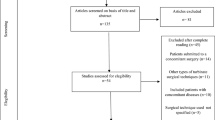Abstract
Olfactory disorders are not rare and affect quality of life in patients. The purpose of our study was to evaluate the outcomes of an outpatient-based diode laser inferior turbinate reduction (ITR) in otherwise therapy-refractory olfactory disorder. In a prospective clinical investigation, 20 patients (7 male, 13 female, mean age 53.2 ± 15.34) with olfactory disorder and 10 patients (8 male, 2 female, mean age 52.5 ± 17.55) without olfactory disorder underwent ITR under videoendoscopic control with a continuous diode laser in “contact” mode after topical anesthetic preparation. Treatment efficiency was assessed before and 2 months after surgery. Subjective nasal airflow (NA) and the olfactory function were rated by means of visual analogue scales (VAS). Olfactory function was assessed using the “Sniffin’ Sticks” test battery. VAS showed very low median values for intraoperative pain (0) [0–1.20] and high postoperative patient satisfaction (8) [5–9]. After 2 months there was no significant improvement of objective olfactory function as measured by the TDI score (threshold, discrimination and identification). The VAS displayed a slight significant improvement in the group of patients with olfactory disorder from 2.95 to 3.65 (P = 0.04). After 2 months, NA data revealed a statistically significant improvement of subjective VAS from 5.05 to 6.25 (P < 0.0005) and of objective NA from 353.77 to 443.50 (P = 0.007) as measured by rhinomanometry in both groups. Outpatient diode laser ITR represents an effective option providing recovery by NA improvement but not a significant improvement of the olfactory function.

Similar content being viewed by others
References
Nordin S, Brämerson A (2008) Complaints of olfactory disorders: epidemiology, assessment and clinical implications. Curr Opin Allergy Clin Immunol 8:10–15
Hummel T, Nordin S (2005) Olfactory disorders and their consequences for quality of life–a review. Acta Oto-Laryngol 125:116–121
Damm M, Temmel A, Welge-Lüssen A et al (2004) Epidemiologie und Therapie von Riechstörungen in Deutschland, Österreich und der Schweiz. HNO 52:112–120 Article in German
Reden J, Mueller A, Mueller C et al (2006) Recovery of olfactory function following closed head injuries or infections of the upper respiratory tract. Arch Otolaryngol Head Neck Surg 132:265–269
Hummel T, Sekinger B, Wolf SR et al (1997) Sniffin’ sticks: olfactory performance assessed by the combined testing of odor identification, odor discrimination and olfactory threshold. Chem Senses 22:39–52
Kobal G, Klimek L, Wolfensberger M et al (2000) Multicenter investigation of 1036 subjects using a standardized method for the assessment of olfactory function combining tests of odor identification, odor discrimination, and olfactory thresholds. Eur Arch Ororhinolaryngol 257:205–211
Welge-Lüssen A, Wolfensberger M, Kobal G et al (2002) Basics, methods and indications for objective olfactometry. Laryngorhinootologie 81:661–667 Article in German
Hummel T, Klimek L, Welge-Lüssen A et al (2000) Chemosensory evoked potentials for clinical diagnosis of olfactory disorders. HNO 48:481–485 Review. Article in German
Goektas O, Fleiner F, Sedlmaier B et al (2009) Correlation of olfactory dysfunction of different etiologies in MRI and comparison with subjective and objective olfactometry. Eur J Radiol 71(3):469–473
Caffier PP, Frieler K, Scherer H et al (2008) Rhinitis medicamentosa: therapeutic effect of diode laser inferior turbinate reduction on nasal obstruction and decongestant abuse. Am J Rhinol 22:433–439
Clement P (1984) Committee report on standardisation of rhinomanometry. Rhinology 22:151–155
Gordon AS, McCaffrey TV, Kern EB et al (1989) Rhinomanometry for preoperative and postoperative assessment of nasal obstruction. Otolaryngol Head Neck Surg 101:20–26
Seiden AM (1997) Olfactory loss secondary to nasal and sinus pathology. In: Seiden AM (ed) Taste and smell disorders. Thieme, New York, pp 52–71
Fukazawa K (2005) A local steroid injection method for olfactory loss due to upper respiratory infection. Chem Senses 30:212–213
Holm AF, Fokkens PJ (2001) Topical corticosteroids in allergic rhinitis; effects on inflammatory cells and mucosa. Clin Exp Allergy 31:529–535
Mygind N, Lildholdt T (1996) Nasal polyps treatment: medical management. Allergy Asthma Proc 17:275–282
Lildholdt T, Rundcrantz H, Lindqvist N (1995) Efficacy of topical corticosteroid powder for nasal polyps: a double-blind, placebo-controlled study of budesonide. Clin Otolaryngol 20:26–30
Ostwald J, Graumüller S, Dommerich S et al (2003) Influence of rhinologic usual and unusual drugs on fibroblasts from nasal polyps in cell culture. Laryngorhinootologie 82:408–415 Article in German
Heilmann S, Just T, Goektas O et al (2004) Effects of systemic or topical administration of corticosteroids and vitamin B in patients with olfactory loss. Laryngorhinootologie 83:729–734
Stuck BA, Blum A, Hagner AE et al (2003) Mometasone furoate nasal spray improves olfactory performance in seasonal allergic rhinitis. Allergy 58:1195
Panagou P, Loukides S, Tsipra S et al (1998) Evaluation of nasal patency: comparison of patient and clinician assessments with rhinomanometry. Acta Otolaryngol 118:847–851
Yaniv E, Hadar T, Shvero J et al (1997) Objective and subjective nasal airflow. Am J Otolaryngol 18:29–32
Sroka R, Janda P, Killian T et al (2007) Comparison of long term results after Ho:YAG and diode laser treatment of hyperplastic inferior nasal turbinates. Lasers Surg Med 39:324–331
Jackson LE, Koch RJ (1999) Controversies in the management of inferior turbinate hypertrophy: a comprehensive review. Plast Reconstr Surg 103:300–312
Chang CW, Ries WR (2004) Surgical treatment of the inferior turbinate: new techniques. Curr Opin Otolaryngol Head Neck Surg 12:53–57
Feron F, Perry C, McGrath JJ et al (1998) New techniques for biopsy and culture of human olfactory epithelial neurons. Arch Otolaryngol Head Neck Surg 124:861–866
Leopold DA, Hummel T, Schwob JE et al (2000) Anterior distribution of human olfactory epithelium. Laryngoscope 110:417–421
Conflict of interest
None to declare
Author information
Authors and Affiliations
Corresponding author
Rights and permissions
About this article
Cite this article
Göktas, Ö., Lau, L. & Fleiner, F. Effect of Laser Treatment on Olfactory Dysfunction. Indian J Otolaryngol Head Neck Surg 66 (Suppl 1), 173–179 (2014). https://doi.org/10.1007/s12070-011-0413-5
Received:
Accepted:
Published:
Issue Date:
DOI: https://doi.org/10.1007/s12070-011-0413-5




